
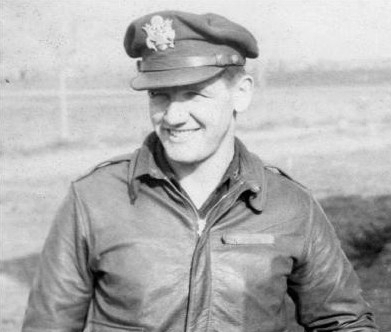
1st Lt. Dean R. Gilmore, Italy, 1944, while with the 111th TRS
This page is dedicated to the memory of 1st Lt Dean R. Gilmore, DFC, a P-51 Mustang pilot, who flew 91 missions with the 111th TRS in the MTO in F-6A Mustang recon ships and also is credited with one enemy aircraft damaged in aerial combat. Upon completion of his tour of duty, he returned to the Z.I. and was appointed as a flight instructor at Bartow Army Air Field, FL, where he used his combat experience to train numerous future fighter pilots in preparation for their duty overseas. During one of these training missions on 14th November 1944, 1st Lt. Dean R. Gilmore crashed with his aircraft into Lake Louisa, FL, and was instantly killed.
Here is the full story of this man and his aicraft:

(The remarkable life of a WW II Pilot and the legacy of his P-51B Mustang)
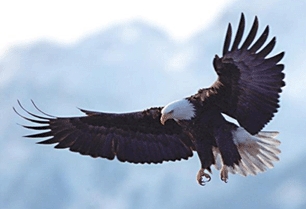
Based on an essay written by Karen Gilmore-Trimble, grand-niece of 1st Lt. Dean R. Gilmore.
Dean Gilmore was born, November 14, 1921, in a small Pennsylvania community, on the East coast of the United States. He was raised on a farm as just one of nineteen children. For as long as anyone could remember, Dean always had been fascinated by airplanes. These were the early days, when the U.S. Mail planes would make their runs through the Pennsylvanian valleys on a regular basis. Dean’s older brother, Charles, was also fascinated by aviation and was an experienced pilot himself. Charles and his wife owned a farm near Dean’s home. A friend of the family used to park his aircraft in a field on Charles’ farm. This is where Dean most probably had his first airplane ride, which led to his lifelong love for aviation and airplanes.
Dean was a very bright and very popular young man. He always was class president, from his freshman through his senior years at East Penn’s Valley High School, from which he graduated in 1940. He was an Athletic All American captain of both his baseball and soccer teams. The caption under his senior picture reads as follows:
“Every class must have its executive, we have ours in Gilly. He has led our class as president for four years and now he wants to be an executive in an airline company. He has been interested in aviation since he learned its fundamentals. He expects to make America air-minded. To put the airplane in the place where the automobile is today. Good luck Gilly. Fly back to East Penn for a visit some bright day.”
Such a bright future for this young man; but then the war came.
Army Air Force
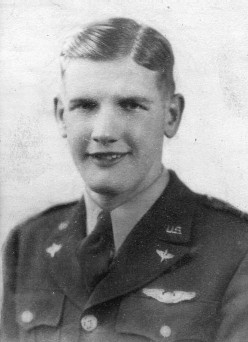
Dean enlisted in the Army Air Force on June 3, 1942. He, along with 4’000 other Air Cadets, reported to Maxwell Field, GA, for pre-flight training. He wrote of his training in a letter to his hometown newspaper, dated February 25, 1943. Dean spoke of the rigorous schedule they all had to endure, and of the class system which was firmly in place. It seems that upperclassmen delighted in inventing new ways to keep the young cadets in check. The schedule was as follows: One half day of classes, and the other half day was spent on drill, athletics and parade. Drill consisted on one hour of marching, daily. The cadets also had to endure two cross country runs per week. These runs were seven miles long and the requirement was to run from start to finish. Dean reported that one cadet ran himself to death one hot day.
After surviving the rigors of pre-flight training, Dean went on to Primary Flying School at Carlstrom Field, FL, a civilian owned airfield under contract to the Army Air Force. Dean described Carlstrom Field as being like a country club. All they had to do was to go to ground school and learn to fly. Dean states that it was there where he learned the meaning of the term “wash out”. He talked of how this affected the men who had their hearts set on flying. By the time Dean left Carlstrom Field, the original cadre of 4’000 was down by half.
Next it was to Bainbridge Army Air Field, GA, for Basic Flying Training. This was an Army school with Army instructors, and the cadets all feared that this next step would be difficult. However, Dean wrote that after a few hours in the Vultee BT-13 trainer, commonly known as “Vultee Vibrator”, all could fly with a relative degree of safety. Dean described the BT-13 as “a pretty nice airplane to fly”. Before the end of Basic Flying Training, the group had lost another fifteen percent of its original number due to “wash out”.
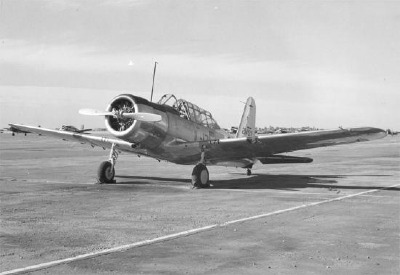
The Vultee BT-13 Basic Trainer, commonly known as "Vultee Vibrator"
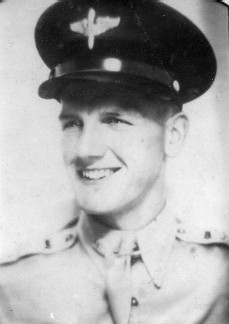
Then, finally, the day arrived when Dean and his remaining classmates were recognized by the Army Air Force as pilots and sent to Marianna Army Air Field, FL, for Advanced Flying Training in what Dean described as “the sweetest flying airplane in the world”, the North American AT-6C. Dean went on to describe how they all loved to fly this type, and that there wasn’t anything one couldn’t do with it. Doing slow rolls, loops or anything until one got bored, but the airplane always would respond to the controls, just as sweet as ever. After completing more than half of the training at Marianna AAF, the outfit deployed to Elgin Army Air Field, FL, for gunnery practice. For this, the AT-6C’s were equipped with .30 cal. Brownings in engine cowling mounts. Gunnery included firing at ground targets, and at targets towed by another aircraft (air-to-air gunnery). For the pilots this proved to be fun, pulling the trigger and to hear the clatter of the gun, thinking how it would be in a fighter aircraft with six or even eight guns. At Advanced Flying School, the class lost another twelve percent of its original number, leaving mere twenty-three percent to graduate. The others that had washed out along the line usually went on to become bombardiers or navigators on heavy bombers.
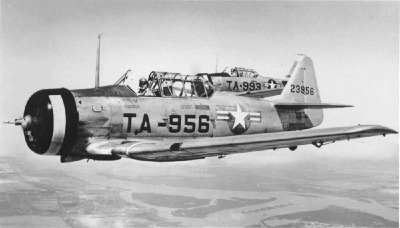
North American AT-6C Advanced Trainers flying in formation
Dean closed his letter to the Millheim Journal by telling of flying all over the Southern United States and not one State could compare to his home state Pennsylvania. He also took the chance to say “Hello” to everyone at home, hoping to see them all again when the war would be over. Sadly, this was not meant to be.
MTO - Italy - 111th TRS "The Snoopers"
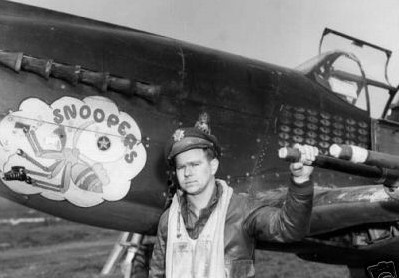
Unknown pilot in front of a F-6A (Recon version of the P-51) assigned to the 111th TRS "The Snoopers" - see nose-art !
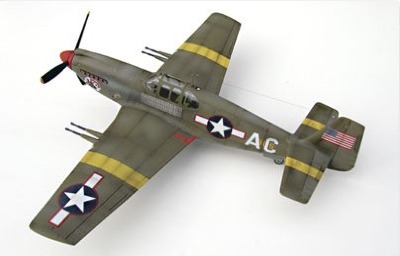
Photo of a model showing a F-6A in 111th TRS colors
After graduating from Advanced Flying School, Dean was posted to the Mediterran Theatre of Operations (MTO) in August 1943. On October 6, 1943, he joined the 111th Tactical Reconnaissance Squadron (TRS) nicknamed “The Snoopers”, at that time stationed in Southern Italy. This unit was equipped with the camera equipped recon version of the P-51, designated F-6A. These were aircraft originally destined for the RAF under Lend-Lease contracts as Mustang IA's (Model NA-91), but were repossessed by the USAAF and equipped with additional cameras for tactical recon duties.
F-6A of the 111th TRS "The Snoopers" in Italy.
While with the 111th TRS, Dean flew 91 missions and by the time he returned to the U.S. in April 1944, he had a total of 194 combat flying hours and had flown more missions than anyone else ins his squadron.
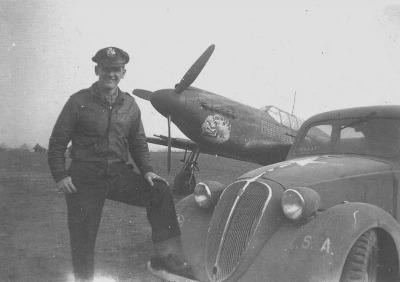
1st Lt. Dean R. Gilmore when with the 111th TRS in Italy, in the background his F-6B recon Mustang, adorned with the squadron emblem "The Snoopers".
In early 1944, in a letter to his sister Geraldine, Dean wrote about some close calls he had had during his tour of duty in Europe. He always came through each of his missions unscathed, but his aircraft was not always as fortunate, often being hit by ground fire and in need of repair. He also told of shooting down one enemy plane during one of his missions.
Dean was given a period of R&R in Italy, and was promoted to the rank of 1st Lieutenant on February 25, 1944.
On March 15, 1944, the 111th TRS was stationed near the Abbey of Monte Cassino, where long and fierce battles between German and Allied troops were being fought. On this day Dean and his “weaver” (wingman) were sent on a mission to relay information to the artillery units in order to clear out the entrenched German units. For his skill and bravery that day, Dean was awarded the Distinguished Flying Cross (DFC).
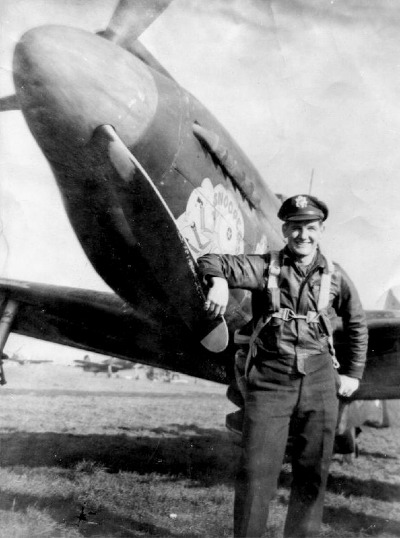
1st Lt. Dean R. Gilmore in Italy, 1944
By the end of March 1944, Dean had flown 87 missions, but would fly four more before returning home to the Z.I. (Zone of Interior) upon completion of his tour of duty in April 1944.
Returning to the U.S., Dean was assigned to Bartow Army Air Field, FL, and was appointed Flight Instructior in July 1944. Bartow AAF was a Combat Crew Training Center for Fighter Pilots, and was equipped with various versions of the P-51 Mustang, both Allison and Merlin engined.
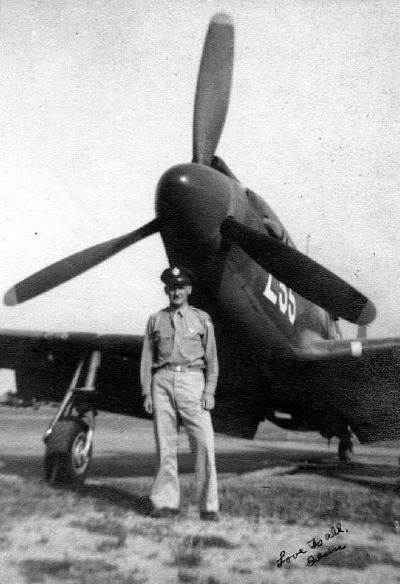
1st Lt. Dean R. Gilmore in front of a P-51A at Bartow AAF, FL.
On November 3, 1944, Dean flew home to Pennsylvania in a P-51B on what would be his last trip home. He flew to Williamsport, PA, where he was met by his older brother Charles, who drove Dean home to Millheim, PA. While at home, Dean confided to his sister that on his next furlough he was going to ask his sweetheart to marry him. He also planned to return to Europe for a second tour of duty at the beginning of 1945.
On Sunday, November 5, 1944, Dean stopped at Charles’ home which now was in Mill Hall, PA. Charles' son, John, who was 18 at that time, asked his uncle Dean if he was going to fly his P-51 over the house. Dean told him, he might. About an hour later, John heard the beautiful sweet sound of a Merlin engine roaring overhead. He ran outside to see Dean heading up the valley. On his return pass, Dean buzzed the house so low that the maple tree leaves were still blowing five minutes later. Dean tipped his wings to John as he returned to Bartow AAF, FL. This was the last time, John saw his uncle alive.
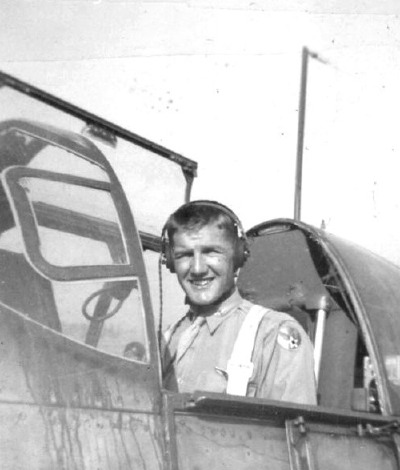
1st Lt. Dean R. Gilmore sitting in the cockpit of a P-51A at Bartow AAF, FL, Summer 1944.
The following Thursday, November 9, 1944, the Millheim Journal reported that Dean was awarded the DFC. They included the text from the citation which read:
“Dean R. Gilmore, 0-799555, First Lieutenant, Tactical Reconnaissance Squadron.
For extraordinary achievement while participating in aerial flight as pilot of a P-51 type aircraft. - On March 15, 1945, Lt. Gilmore flew on a two-plane mission to adjust heavy artillery gunfire upon enemy sites near Cassino, Italy. Skillfully maneuvering his fighter plane through tense anti-aircraft fire, Lt. Gilmore relayed exact information enabling our guns to silence two 88 mm gun batteries, one heavy gun battery and a dual-purpose gun position. While adjusting fire upon a fifth target, twelve Messerschmitt Me-109’s attacked Lt. Gilmore and his weaver. Displaying outstanding courage and flying ability as he maneuvered the two-plane element against tremendous odds, Lt. Gilmore damaged one enemy aircraft before breaking off and returning safely to home base.
His steadfast devotion to duty and outstanding proficiency as combat pilot reflect great credit upon himself and the Armed Forces of the United States."
Just one week later, the same paper would report Dean’s death.
November 14, 1944
November 14, 1944, was Deans twenty-third birthday. From all accounts the day was a rather routine one. Dean had done 30 minutes of flying early in the day, and at 4.15 h p.m. he took off again on a routine training mission, leading four junior pilots……
Dean was flying an unpainted P-51B-1-NA, serial # 43-12252, on this day. The Mustang had a red spinner and the aircraft identification letters “L5” painted in red on the cowlings. On the tail was the squadron emblem of the 56th Fighter Squadron 54th Fighter Group, the unit that originally had trained P-51 pilots out of Bartow AAF, but had been disbanded on May 1st, 1944, with planes and personnel going to the 340th Army Air Force Base Unit, taking over the duties of the 56th FS.
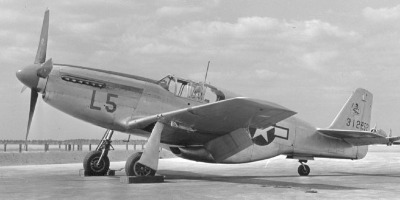
P-51B-1-NA 43-12252 seen here on April 17, 1944, during a visit to Hillsborough AAF, FL (click on photo for a larger version)
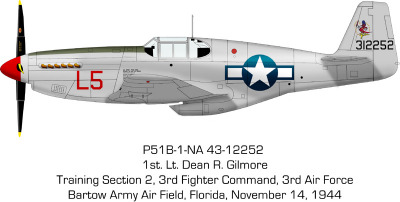
A profile © of Dan Johnson based on above photograph (click here for a larger version)
43-12252 had been completed at the North American Aviation factory at Inglewood, CA, on September 29, 1943, and was issued to the 3rd USAAF 3rd Fighter Command for duty as training aircraft.
Until November 14, 1944, this aircraft had accumulated a total flying time of almost 1’650 hours without any major incident.
1st Lt. Dean R. Gilmore took off that day in 43-12252, followed by four more aircraft:
2nd Lt. Samuel Pesacreta in P-51B 43-12258 (as wingman)
2nd Lt. John H. Junkins in P-51C 44-10909
2nd Lt. Eric W. Hutchinson in P-51B 43-12118
2nd Lt. Robert A. Dunn in P-51B 43-12492
Their mission was a low-level navigation mission, comprising of a two lap circle around Lake Louisa, FL, North of Bartow AAF. According to the wingman and the other members of that flight, the first lap of this mission was accomplished without incident, but on the second leg of their journey, something went terribly wrong. As the five planes swooped low over the trees bordering Lake Louisa, Dean’s aircraft went into a gradual descent and slammed into the lake, exploding in a fiery ball on impact.
At the same time, Frank and Isabel Wright were out fishing on the lake, and witnessed the crash from approx. 500 yards distance. From a written account they gave the day following the accident, a clear picture of the incident emerges:
They reported that as the plane descended from about 200 feet altitude, it appeared to be cutting low, and when it tried to recover, it appeared to bounce, much like a stone skipping across the water. The plane then exploded in a fireball and debris rained all around the impact point in shallow water
Mr. and Mrs. Wright immediately rowed to the crash site, and looked for signs of life, but found none. Gasoline was pouring from one of the ruptured wing-tanks and oxygen bottles and papers were floating on the water. They then noticed something white floating about fifty feet from the main wreckage, and upon closer inspection they discovered it was the partially deployed parachute. Floating under the parachute was Dean Gilmore’s lifeless body.All through this action, Dean’s flight circled the crash site, with one aircraft flying very low (Hutchinson). The Wright’s took Dean’s body to shore and signaled this low circling pilot that they had found his comrade dead, upon which the entire Mustang flight departed for Bartow AAF. Dean then was taken away by an Ambulance.
Eleven hundred miles away, Dean’s father Harry received news from his children that his youngest son was gone. Dean’s body was accompanied home by one of his comrades. From all accounts, Dean’s funeral was enormous. The local church was filled to capacity, with people lined up four blocks away to pay their respect to this local fallen hero. This ended the life of a brilliant, talented, well loved young man.
For over fifty years, Dean was lovingly remembered by his family, but the only public remembrance of this brave young man was a picture which hangs in the local American Legion in Millheim. Also more than fifty years, the remains of Dean’s aircraft lay hidden from view under Lake Louisa waters.
Wreck discovered !
That was until 2001. Central Florida was in the midst of a severe three year drought that year. The water level at lake Louisa had dropped to a one hundred year low. Two young boys were out on the lake kayaking on June 26, 2001, when they noticed something sticking out of the water. Upon inspection, they realized that it was two severely twisted propeller blades still attached to their hub. They immediately rowed to shore and contacted park officials. The park manager contacted the county Sheriff’s Department, who sent a dive team to recover the wreckage. The first concern officials had was that this possibly was a new wreck, but the profuse amount of algae covering the surfaces soon led the officials to the conclusion, that the wreck had been there for some time. All that was recovered was the propeller, the radiator, the battery, part of a wing and a pile of assorted pieces. It was obvious that a good deal of wreckage had been removed prior to its most recent discovery.
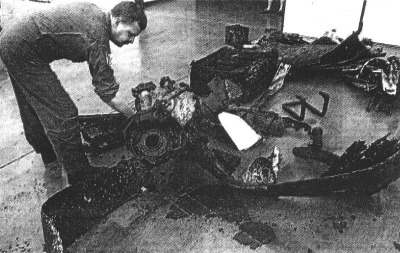
The bent and corroded bits and pieces of 43-12252 after recovery.
The next focus of the investigation was twofold. What type of airplane was it, and what had happened to the pilot ? A series of four newspaper articles ran in the Orlando Sentinel, asking anyone with information to please come forward. The first thought was that this was a Curtiss P-40 Warhawk, but soon it was determined from the wreckage, that it in fact was a P-51 Mustang.
After reading of the search for the pilot’s identity and his possible location, Mrs. Caldwell, a lifelong Florida resident came forward with an old letter written by Mr. Ward Harker, Base Commander at Bartow AAF, to Mr. & Mrs. Wright, thanking them for their efforts to save Dean's life. Mrs. Caldwell’s son had been tearing down the Wright family home in the late 1980’s, and had come across this letter. He knew that his mom liked to collect old things so he gave the letter to her. She tucked it away and the letter was forgotten for over ten years. With the re-discovery of this letter, a reporter for the Orlando Sentinel began an internet search for Dean Gilmore’s relatives. He eventually found genealogy data posted by Karen Gilmore-Trimble, and contacted her via e-mail on July 3, 2001.
From the time she was a little girl, she always knew of “Uncle Dean” (Dean had been the Uncle of Karen’s father, John, the 18 year old boy mentioned earlier) and the tragic way his life had ended. As she dug into the family history, she often wondered what really had happened on that fateful day over half a century earlier, and what Lake Louisa looked like. The receipt of the e-mail dated July 3, 2001, titled “Looking for relatives of 1st Lt. Dean R. Gilmore” should change Karen’s life.
When she read what had transpired in Florida, Karen was literally dumbfounded, so was her father. They contacted the Orlando Sentinel reporter and got in contact with officials and learned of a plan to honor Dean and all other aviators who flew over Florida during WW II. Initially it was planned for a monument to be placed at Leesburg Airport, which also had been an airfield during WW II. The idea soon was scrapped for several reasons, the most obvious being that Dean had no ties to this Base. Then the decision was made to place a monument at Lake Louisa State Park. The Dedication was to take place on Monday, November 12, 2002, Veteran’s Day.
The four months leading to the ceremony, Karen and her father were kept informed on all developments involving the monument, the wreckage and the dedication ceremony.
Karen spent the time learning everything she could about Dean by digging through old newspapers, and by talking to his only two surviving siblings, Geraldine and Jean.
The story continues in Karen’s own words:
"On November 8, 2002, my Dad and I set out from our homes, to drive the eleven hundred miles to Lake Louisa for the ceremony. We arrived in Clermont on November 9th, and we were treated as honored guests from the moment we arrived. The next morning, Dad and I drove to the lake. We wanted a chance to see the lake before the ceremony. We knew it would be very emotional. We were greeted by the Park ranger and his staff. We were taken to the monument which stands seven feet tall, and has a tip of a propeller blade from Dean’s aircraft embedded in the top of it. As I stood with my back against the back of the monument, and stared off across the lake, I was in direct line with the spot where Dean’s plane had been recovered."
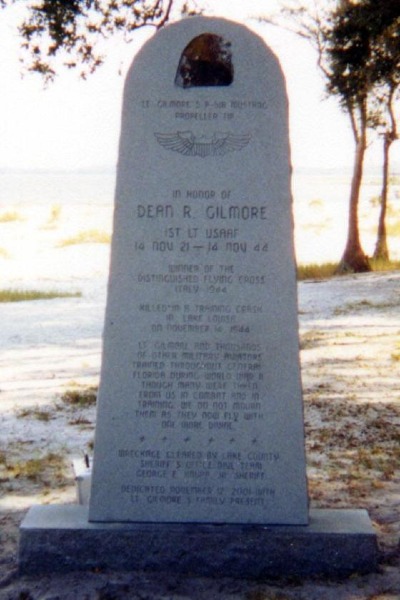
The Memorial at Lake Louisa State Park, FL
"On Sunday, a traditional Veteran’s Day ceremony took place at the Citrus Tower near Clermont. It was here where we had our first glimpse of the wreckage. As I neared the flatbed truck, upon which the pieces lay, I was overcome with emotion. I never through that a pile of twisted metal could have such a powerful effect on me, but to see the force which was needed to turn this once beautiful machine into this twisted wreck was very powerful indeed. Dad and I were asked to speak, and after we finished, we were presented with a shadowbox containing miniatures of Dean’s ribbons, silver wings and his 1st Lt bars. It was a beautiful tribute.
Monday, November 12, 2001, dawned bright and beautiful. It was two days before the 57th anniversary of the crash, and also two days before what would have been Dean’s 80th birthday. We arrived at the lake at 9.00 a.m. and were met by a multitude of television reporters. After giving several interviews, the ceremony began and again we were asked to speak. As I stood in front of all those people and talked about Dean, I realized how truly blessed I was to get to know such a wonderful young man. After the monument was unveiled, we were presented with a plaque that contained another tip from the propeller from Dean’s plane, and also a rudder pedal.
As the Chaplain began the benediction, we heard the hum of a Merlin engine heading towards us. Seconds later, Kermit Weeks roared overhead in P-51D “Cripes A’ Mighty”, and gave us all quite a show. He made five passes, from various angles, and on his last pass, he tipped his wings in farewell, the same way Dean had done for my dad all those years before. As we watched the Mustang leave our sight, a beautiful American Bald Eagle appeared, circled and landed on the sand bar where the wreckage was recovered."
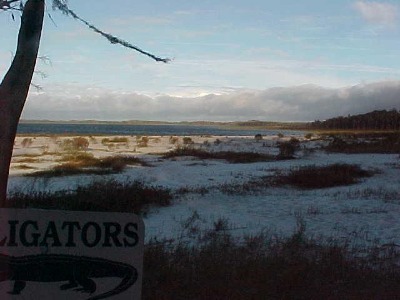
View of Lake Louisa towards the spot where Dean R. Gilmore had perished.
"My dad’s closing remarks in the speech he gave were “My one regret is that Dean is not here to share the dedication of this beautiful monument and to reminisce with his comrades in arms”, but as the Eagle landed on the crashsite, I knew in my heart that Dean was indeed with us that beautiful day."
Another chapter in this amazing story:
A few months after the ceremony in Florida, Jack Roush purchased the remains of Dean’s aircraft and started reconstructing it to flying condition. Today, three years later, this restoration is nearing completion and this rebuilt aircraft soon will grace the skies.
This newly built aircraft will be registered with the serial of Dean’s aircraft, 43-12252, but does not incorporate much of the original aircraft itself. This rebuild will be painted in wartime colors of an England based Fighter Group, as tribute to another pilot and fighter ace; but when it will be displayed at airshows in the near future, it shall never be forgotten that this rebuild originated from the wreckage of Dean’s aircraft and his ultimate sacrifice to his country.
With sincere thanks to Karen Gilmore-Trimble and her dad, John Gilmore, for sharing their memories and photographs, thus enabling me to produce this page.
My thanks also go to Dan Johnson for the profile used on this page.

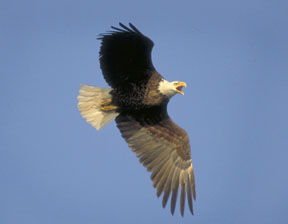
© Martin Kyburz / Swiss Mustangs 2003 - 2009

